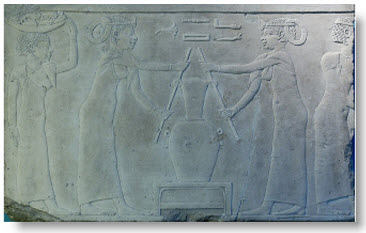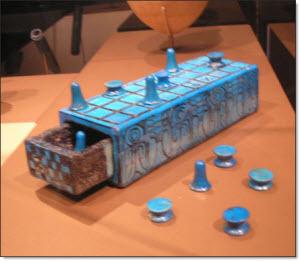Daily Life in Ancient Egypt

A Small Wooden Model of an An Ancient Egyptian Farmer
Tilling His Fields With the Help of Oxen.
This model currently is on display at the Louvre
and dates from the Middle Kingdom and was made
around 2000 B.C.
The image was adapted from a photograph taken by Janmad
and was released under the GNU Free Documentation License
Ancient Egypt is known to us primarily through the ruins of its colossal architecture: the temples, statues and pyramids. These giant structures can tell us a lot about how the ruling classes and the priests lived, but they do not accurately reflect the daily life of the majority of Egyptians, the peasants and ordinary folk who toiled to build these amazing monuments.
The majority of Egyptians were peasants who farmed small plots of land; although not slaves, they were tied to their land, and were required to provide services to the ruling class, such as working on the construction of temples and public works.
Archaeological research shows that the average Egyptian peasant lived fairly well, with an adequate diet consisting mainly of bread and beer, with some vegetables such as onions, garlic, and fruits, primarily figs and dates. The average Egyptian would only eat meat on holidays, while the wealthier would eat meat more frequently.

Ancient Egyptian Painting
of a Woman Playing a Music Instrument
The home of an Egyptian peasant was invariably built of mud bricks, and was well designed to stay cool inside despite the hot days. The focal point of the house was the kitchen, which contained an oven to bake bread and a mill to grind flour. The stoves did not have chimneys and instead the smoke veneted directly through an opening in the roof. The inside of the house was simply decorated but did not lack comfort: the floors were usually covered with reed mats; the walls were painted and sometimes were also covered with colored linen.
The furniture was made of wood and most houses had wooden stools, tables and raised beds.
The ancient Egyptians gave great importance to hygiene and appearance. They bathed frequently in the Nile and used soap pastes based on animal fat and chalk. The men shaved their heads and their entire bodies and used perfumes and aromatic ointments to cover bad odors. It was normal for men, as well as wealthier women, to use cosmetics. The men typically wore wigs, as did wealthy women.
The Egyptians wore clothes made from sheets of white linen. Children did not wear clothes until the age of puberty. On reaching puberty, the boys were circumcised.

The making of lily perfume.
Fragment from the decoration of a tomb,
4th dynasty of Egypt-(2500s BC).
Men traditionally worked oustide the household while the women were primarily responsible for raising the children and running the household. However, men and women enjoyed equality of legal rights and both could sue in courts of law, and own land and property. There are several known cases of women working as scribes, and other traditionally male occupations.
Marriage was consensual and usually between one man and one woman, although polygamy was not forbidden. Males usually married at the age of 18 to 20 while females married between the ages of 15 and 18. Egyptians usually married cousins or other family members. Pharaohs were known to marry their sisters, but this was not common practice among the peasant class. Marriage to non relatives was discouraged. The sage Scribe Ani, wrote during the New Kingdom:
"Beware of a woman who would is unknown in your city. Do not look at her as is she were better than the others, do not know her physically: she is like a very deep water which we do not know the currents. "
The ideal of Egyptian family life was for a man and a woman to settle down together and make a home and have children. Most Egyptians wished to have at least one boy.

A Photograph of A Senet Board and Pieces.
Senet was a popular game among the ancient Egyptians
and is believed to be the oldest board game.
This photograph was taken by Deror Avi.
The Egyptians enjoyed a number of recreational activities including games and music. There were many religious and secular festivals and elebrations throughout the year which provided entertainment and relief from work. Music and dance were a part of daily life, with the flute and the harp being commonly used. Later the trumpet and the oboe were also introduced to Egypt, and later the cymbals, tambourines and drum, as well as the Asian lute were also adopted by the Egyptians.
One popular game played by the Egyptians was called Senet, which consisted of moving pawns and pieces on a checker board. The name of the game Senet can be translated as the "game of passing". Senet is believed to be the oldest board game in the world. Another game played by the Egyptians was called Mehen, and named after a serpent god which protected Ra during his journey through the underworld every night. However the rules of this game are not known.
Juggling and ball games were also popular among children. The upper classes hunted for leisure. Egyptian forms of boxing and wrestling were especially popular among all classes of Egyptians.
pyramids Egypt Mummies Search Engines Link Report
Egyptian Cities | Egyptian Education | Ancient Egypt | egyptian clothing | Egyptian Houses | The Egyptians | Egyptian Family Life | Egypt and its Neighbours | Government in Ancient Egypt | Egyptian History | Military | Organization of Ancient Egypt | Recreation | Egyptian Religion | Pyramids | About | Privacy Policy | Site News | Site Map
EgyptPast.com - Facts and Information About the History of Ancient Egypt
-